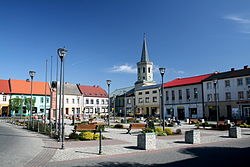Bieruń
| Bieruń | ||
|---|---|---|

Market square in Bieruń
|
||
|
||
| Coordinates: 50°8′N 19°6′E / 50.133°N 19.100°ECoordinates: 50°8′N 19°6′E / 50.133°N 19.100°E | ||
| Country |
|
|
| Voivodeship |
|
|
| County | Bieruń-Lędziny | |
| Gmina | Bieruń (urban gmina) | |
| Area | ||
| • City | 40.67 km2 (15.70 sq mi) | |
| Population (2008) | ||
| • City | 19,464 | |
| • Density | 480/km2 (1,200/sq mi) | |
| • Urban | 2,746,000 | |
| • Metro | 5,294,000 | |
| Postal code | 43-150 | |
| Website | http://www.bierun.pl | |
Bieruń [ˈbʲɛruɲ] (German: Berun) is a town in Upper Silesia, in southern Poland, about 25 km (16 mi) south of Katowice. The town belongs to the Silesian Voivodeship since its formation in 1999, previously to Katowice Voivodeship and, before World War II, was part of the Polish Autonomous Silesian Voivodeship.
It is located in the Silesian Highlands, on the Gostynia river, a tributary of the Vistula. In the north it borders on the Metropolitan Association of Upper Silesia - metropolis with a population of about 2 million.
Bieruń is one of the towns of the 2.7 million conurbation - the Katowice urban area, and within the greater Silesian metropolitan area populated by about 5,294,000 people. The population of the town itself is 19,464 (2008). Bieruń includes dzielnicas Bieruń Stary, Bieruń Nowy, Ściernie, Jajosty, Bijasowice and Czarnuchowice and is bordered with Lędziny, Tychy, Chełm Śląski, Bojszowy and Oświęcim.
The settlement of Berouna was first mentioned in a 1376 deed, when Silesia belonged to the Bohemian Crown. The name is most probably related to the, similarly spelled, Slavic deity Perun, remains of its cultic place still present at nearby Lędziny. John II of Opava, the Přemyslid duke of Racibórz granted it town privileges in 1387. A part of the united Duchy of Opole and Racibórz Bieruń was incorporated by the Habsburg Monarchy in 1532.
...
Wikipedia


